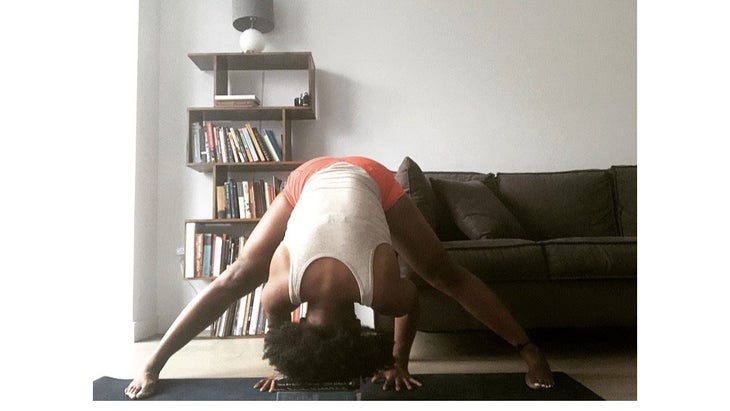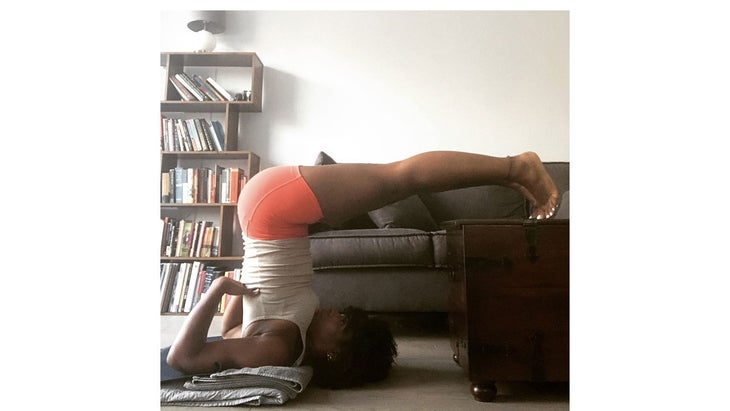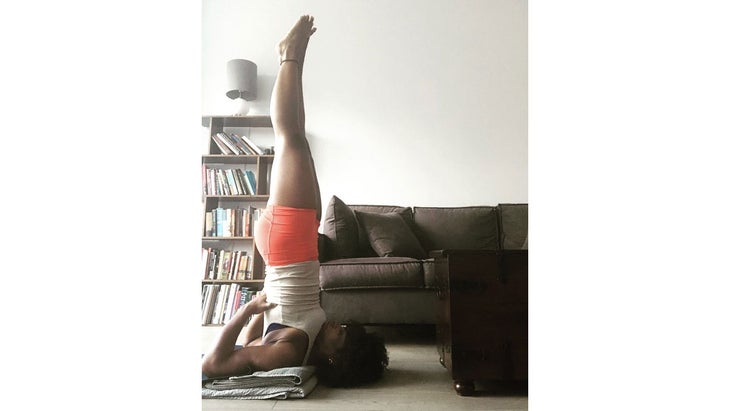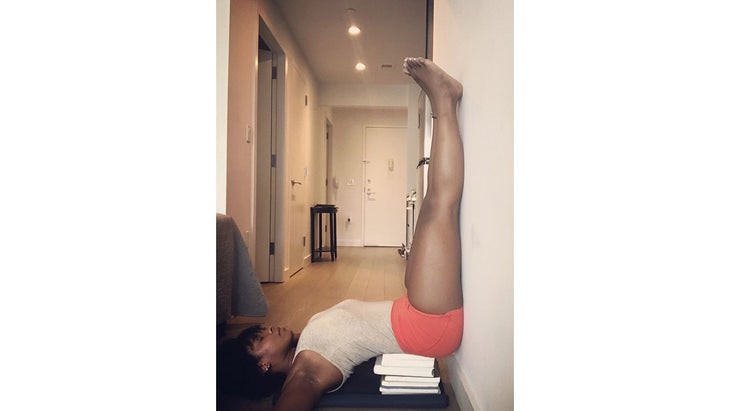Heading out the door? Read this article on the new Outside+ app available now on iOS devices for members! Download the app.
Stress weighs heavily on the immune system. Fortunately, yoga helps boost mental and emotional health, and can balance your immune system, helping it function well. Poses like inversions and restorative or supported shapes help calm your nervous system and promote a general feeling of wellbeing. This Iyengar-inspired sequence, by Deidra Demens, a New York City-based Iyengar Yoga teacher, opens up the entire body, which is particularly helpful when we’ve been indoors all day. Your head is supported in each pose, allowing you to calm the mind and quiet the senses.
Adho Mukha Svanasana Variation (Downward Facing Dog Pose) with Head Support

From all fours, separate your feet hip width apart, and your hands shoulder width apart. Tuck your toes under and raise your hips to the ceiling as you press your thigh back toward the wall behind you. Straighten your arms and legs. Stack pillows or books under your head until you can rest your head and neck.
See also Downward Facing Dog Step by Step
Uttanasana (Standing Forward Bend)

From Downward-Facing Dog Pose, walk your feet forward toward your hands until your feet are under your hips. With your legs straight, press your thighs back. Spread your elbows to extend the sides of your body. Rest your head on a stack of books, pillows, or a chair.
See also Uttanasana Variations
Prasarita Padottanasana (Wide-Legged Standing Forward Bend)

Stand with your legs wide apart. Bend forward and place your hands on the floor shoulder width apart. Keep your legs straight and bend your elbows. Rest your head on a stack on books, pillows, or a chair.
See also Learn Prasarita Padottanasana
Salamba Sirsasana (Supported Headstand)

Fold up a yoga mat and place it against the wall. If you don’t have a mat, you can fold a couple of towels or a small blanket to support your head. Kneel in front of the mat and place your forearms down on the mat. Interlock your fingers and take your knuckles to the wall. Position your elbows shoulder width apart. Place the crown of your head on the props. Press the bases of your palms together and snuggle the back of your head against your clasped hands. Tuck your toes under and walk your feet toward your head.
Optional: Take both feet up at the same time, even if it means bending your knees and hopping lightly off the floor. As your legs (or thighs, if your knees are bent) rise to perpendicular to the floor, firm your tailbone against the back of your pelvis by engaging your core. Once you are in the pose, continue pressing your forearms down and keep lifting your heels to the ceiling.
See also: A Detailed Breakdown of Headstand
Halasana (Plow Pose)

Fold three or four bath towels or small blankets. Place the props on the floor in front of a chair or coffee table. Lie down on the blankets with your shoulders an inch away from the top edges of your blankets or towels. Press your hands by your sides, palms down. Draw your shoulders toward your midline, and root your arms down to the floor. Reach your legs over your head and place your toes on a chair or coffee table. Place your hands on your lower back for support, and straighten your legs.
See also: Prepare for Meditation and Relaxation With Plow Pose
Eka Pada Sarvangasana (One-Legged Shoulderstand)

From Plow Pose, lift one leg straight up until it is perpendicular to the floor. Press the upper arm bones down and stretch both legs. Lower that leg down and take the other leg up. Repeat this a couple times.
See also Anatomy 101: Understand Neck Safety in Supported Shoulderstand
Salamba Sarvangasana (Supported Shoulderstand)

From One-Legged Shoulderstand, raise the leg that is parallel to the floor up to meet the lifted leg, so that both legs are perpendicular to the floor. With both legs straight and your hands supporting your back, press your forearms down. Reach your toes toward the ceiling as you elongate your legs.
See also Supported Shoulderstand
Sukhasana (Easy Pose)

Sit on the floor with your legs crossed at the center of your shins. Take your right hand to your left knee, and your left hand on the floor or props, if needed, behind your back. With an inhalation, extend both sides of your trunk. As you exhale, spread your elbows and turn toward your left leg. Repeat on the other side.
See also Easy Pose
Viparita Karani (Legs-up-the-Wall)

Place a stack of books about 5 to 6 inches away from the wall. (You could use towels or pillows as support instead of books). Sit sideways on either the left or right side of the support. Swing your legs up onto the wall and release your shoulders and head gently down onto the floor. Open your chest. Rest your legs against the wall, and melt your head and your neck so there is space for your brain to settle back.
See also Release Stress With Viparita Karani
Savasana (Corpse Pose)

Lie down on your back. Extend your legs and stretch your arms by your sides. Rest your entire body. Stay for several minutes.
See also Supported Savasana Variations
See also How to Use Yoga Props Effectively